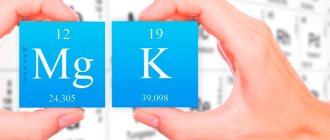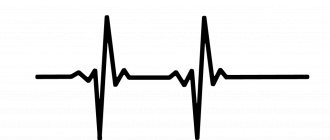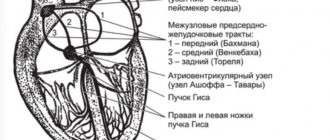Contraindications
Concor should not be used for the following diseases:
- cardiogenic shock;
- acute heart failure;
- chronic heart failure (CHF) in the stage of decompensation, which requires the use of inotropic therapy;
- sinoatrial block;
- atrioventricular (AV) block of II–III degree in patients without a pacemaker;
- severe bradycardia with heart rate less than 60 beats per minute;
- sick sinus syndrome;
- severe arterial hypotension [systolic blood pressure (BP) below 100 mmHg];
- Raynaud's syndrome or severe peripheral arterial circulation disorder;
- severe form of bronchial asthma;
- chronic obstructive pulmonary disease in severe form;
- metabolic acidosis;
- pheochromocytoma (without simultaneous use of alpha-blockers);
- age under 18 years;
- breastfeeding period;
- hypersensitivity to the components of the drug.
Bisoprolol: contraindications and side effects
It is prohibited to take Bisoprolol in the following cases:
- individual intolerance to the active and auxiliary substances;
- heart failure at the stage of decompensation;
- weakness of the sinoatrial node;
- disruption of oxygen conduction from the sinoatrial node to the atrium;
- slow heart rate (less than 60 heart beats in 60 seconds);
- low blood pressure;
- bronchial asthma;
We described in more detail about the manifestation of bronchial asthma in adults and children
- chronic lung diseases;
- Raynaud's disease;
- metabolic acidosis.
Contraindicated
If you do not adhere to the recommended dosages, the drug "Bisoprolol" can cause the following side effects:
- from the central nervous system – headaches, sleep problems, depression, hallucinations;
- visual system – tearing of the eyes, inflammation of the membrane of the eye;
- heart and blood vessels - slow pulse, coldness in the extremities, hypotension;
- respiratory system – rhinitis or bronchospasm;
- Gastrointestinal tract - diarrhea, nausea and constipation;
- skin – rashes, itching, severe sweating, cramps;
- reproductive system – problems with potency.
Full list of side effects
Common side effects include fatigue and asthenia.
Doses and method of administration Concor
Dosage and method of use of the drug Concor
Concor is taken orally (do not chew or crush) once a day with a glass of water, regardless of meals. But there is a dependence on the time of day. The medicine should be taken exclusively in the first half of the day, that is, you cannot take Concor during the day, evening or at night.
As for the duration of therapy, it is determined by the body’s reaction and the decision of the attending physician.
- Arterial hypertension and angina pectoris
The dose of the drug is calculated taking into account the heart rate and general condition of the patient.
To begin with, Concor is prescribed 5 mg, one tablet per day. Then they go up to 10 mg. And in the treatment of hypertension and angina pectoris, the maximum recommended dose is 20 mg per day.
- Chronic heart failure without signs of exacerbation
Initially, 1.25 mg once a day. If the patient tolerates the dosage well, then it is gradually increased every two weeks to 2.5 mg, 3.75 mg, 5 mg, 7.5 mg and 10 mg.
If the dosage is poorly tolerated, then it should be reduced. The maximum recommended dose is 10 mg per day.
Form and composition of the drug Bisoprolol
The drug Bisoprolol is available in tablet form.
Their shade depends on the dosage:
- white – 2.5 mg;
- blue – 5 mg;
- pink – 10 mg.
Color depending on dosage
Blue and white are round in shape, and pink are oval. Regardless of the dosage, the tablets have a doubly convex surface.
Each tablet contains the active ingredient - bisoprolol fumarate. Its quantity can be found out by looking at the packaging or shade of the tablet.
In addition, the drug contains additional substances that enhance the effect of bisoprolol fumarate:
- microcrystalline cellulose;
- calcium phosphate;
- magnesium stearate;
- silicon dioxide dry;
- E171 (colors tablets white);
- E172, E120 and E171 (gives a pink tint);
- E104 and E171 (for blue tint).
Side effects
Taking Concor may be accompanied by side effects:
- From the nervous system: increased fatigue, dizziness, headache, sleep disturbances, depression may be observed (especially at the beginning of therapy), rarely - hallucinations (usually mild and disappear within 1-2 weeks), sometimes - paresthesia.
- On the part of the organ of vision: visual disturbances, decreased tear production (must be taken into account when wearing contact lenses), conjunctivitis.
- From the cardiovascular system: in some cases - orthostatic hypotension, bradycardia, AV conduction disturbances, decompensation of heart failure with the development of peripheral edema, at the beginning of treatment - deterioration of the condition of patients with intermittent claudication or Raynaud's syndrome.
- From the respiratory system: in isolated cases - shortness of breath (in patients prone to bronchospasm).
- From the gastrointestinal tract: in some cases - diarrhea, constipation, nausea, abdominal pain, increased activity of liver enzymes in the blood serum (AST, ALT), hepatitis.
- From the musculoskeletal system: in some cases - muscle weakness, cramps, arthropathy affecting one or more joints (mono- or polyarthritis).
- From the endocrine system: decreased glucose tolerance (with latent diabetes mellitus) and masking of signs of hypoglycemia, in some cases - increased TG levels in the blood, potency disorders.
- On the skin: sometimes - itching, skin hyperemia, increased sweating, rash. When treated with beta-adrenergic receptor blockers, hair loss, hearing impairment or tinnitus, weight gain, mood changes, short-term memory loss, allergic rhinitis, and priapism are observed in some cases.
Concor during pregnancy
Reception during pregnancy is limited
Expectant mothers should be extremely careful when choosing certain medications. In the case of Concor, you can take it only if the benefit to the mother’s body is greater than the damage. Concor should not be taken during lactation, since the baby receives bisoprolol and auxiliary components through breast milk. If discontinuation of the drug is not possible, then breastfeeding should be discontinued.
Interaction with other drugs and alcohol
Combination of Concor with other medications
The instructions for the drug Concor describe in some detail the compatibility with other drugs, because there is a list of drugs with which the Concor tandem is prohibited. Concor can be used in conjunction with analogues and generics, but such a combination must be discussed with your doctor so that an overdose does not occur and the blood pressure does not drop below normal levels.
Concor and Amlodipine
Amplodipine is an antihypertensive drug used for high blood pressure. The attending physician may prescribe a similar tandem if he believes that Concor will be ineffective. It is worth remembering that patients with heart failure cannot take Amplodipine and Concor together.
Concor and Arifon
Arifon - a diuretic indapamide - in combination with the beta blocker Concor is an effective complex in the treatment of hypertension. Concor lowers blood pressure, and Arifon reduces the volume of circulating blood, thus protecting the patient from signs of heart failure.
But Arifon has a side effect - it flushes potassium from the body, which can cause hypokalemia.
Concor and Lozap
The active substance of the drug Lozap, losartan potassium, is intended for the treatment of arterial hypertension. That is, it does not allow peripheral vessels to spasm and thereby does not allow blood pressure to rise. Concor and Lozap enhance each other's effects. Concor works to reduce cardiac output, while Lozap dilates arterioles and reduces peripheral pressure. As a result, blood pressure returns to normal.
The combination of drugs Concor and Lozap is most effective when the degree of arterial hypertension is quite high, and treatment with one drug is not so effective.
Concor and Enap
The simultaneous use of Concor and Enap or Enalapril, which are based on the same active ingredient - enalapril, should be prescribed with caution, since the drugs can enhance the effect of each other. So, the instructions say: with the simultaneous use of beta-blockers, methyldopa, nitrates, calcium channel blockers, hydralazine, prazosin, the antihypertensive effect may be enhanced. That is, blood pressure that was already reduced with the help of the drug Concor can decrease further.
Enap is good for kidney disease, excess weight and a history of diabetes. Concor is indicated for use in patients with heart rhythm disturbances, tachycardia, and frequent attacks of angina. But if the resting heart rate is 50 - 60 beats/min, and there are conduction blockades, then you should take Enap, since Concor will only worsen these conditions.
The combined use of Concor and Enalapril lowers blood pressure and slows the progression of complications from the heart and kidneys. If you experience constant weakness, dizziness and fatigue during use, you should immediately inform your doctor.
Concor and Prestarium
Like all other ACE inhibitors, Prestarium combines well with the β1-blocker Concor. They are prescribed in tandem for high blood pressure, when the use of one drug is ineffective, reducing the risk of fatal complications for people with heart failure, obesity, diabetes, and chronic kidney disease.
But the decision to prescribe the combination Concor + Prestarium is made by the attending physician.
Prestarium itself is not as effective a medicine as Concor. If the pressure is 180/105 mmHg. Art., then it must be taken in combination with other drugs for hypertension.
Concor and Moxonidine
Concomitant use of Moxonidine with β-blockers such as Concor is not recommended. This can lead to a decrease in myocardial contractility and increased bradycardia
Concor and Lorista
Lorista is a generic version of the drug Lozap. That is, it contains the same active ingredient as the original drug, but it has not passed all stages of clinical trials. Generic status makes medicines cheaper without losing their properties. Lorista contains valsartan, a drug belonging to the group of sartans, which are prescribed for the development of a dry cough due to ACE inhibitors. The combination of Concor and Lorista is inferior in strength to the combination of Concor and any ACE inhibitor, since Lorista does not reduce the risk of complications of coronary artery disease.
How does an overdose of Bisoprolol manifest itself, and how to deal with it?
If you exceed the permissible dosage, you may feel:
- dizziness;
- bronchospasm ;
- cyanosis on fingers and palms;
- breathing problems;
- decreased blood pressure;
- heart failure;
- arrhythmia;
- slow pulse;
- convulsions and fainting.
If you feel symptoms of an overdose, you should immediately rinse your stomach. For this purpose, adsorbents can be used. Further treatment depends on what symptoms you experience. To normalize blood pressure, you need to lie in the Trendelenburg position.
The position you need to lie in
In case of heart failure, glycosides or glucagon are used. If convulsions occur, Diazepam should be administered intravenously. In case of bronchospasm, the patient is prescribed inhalations using beta-adenostimulants. In case of hypoglycemia, the patient is given intravenous glucose.
It is also important to consider drug interactions so as not to lead to health problems.
Concor and alcohol
Drinking alcohol with Concor
It is known that when drinking alcohol, blood vessels dilate for a short time, that is, the heartbeat accelerates. True, after a short amount of time the opposite happens - vasospasm. And a sharp rise in blood pressure is not the most pleasant, but also not the most dangerous, thing that can await a patient taking Concor. The instructions directly state that Concor and alcohol are incompatible. The central nervous system is depressed, and the patient’s psychomotor abilities deteriorate. Also, do not forget that the medicine and alcohol will be excreted through one excretory system - the kidneys. This can lead to organ damage, and in some cases functional impairment may develop. Internal bleeding may begin, a hypertensive crisis, pulmonary edema, and vascular collapse may begin. But the worst result of taking Concor and alcohol together is death.
Therefore, doctors strongly recommend that you stop drinking alcohol while taking Concor.
Analogs
When choosing analogues, it is important to understand that each of them has its own indications for use, side effects, contraindications, active substances, etc. It is important to consult a doctor and not change the drug yourself.
Which is better: Concor, Bisoprolol, Coronal?
All of these drugs contain the same active substance - bisoprolol. They have similar contraindications and indications for use.
Bisoprolol is used to treat arterial hypertension, tachycardic heart rhythm disorders, ischemia, heart failure and various forms of arrhythmia. It is considered antihypertensive and lowers blood pressure. Patients whose blood pressure is 90 mm or lower (hypotension) are prohibited from taking Bisoprolol. It is easier to tolerate by patients and there is less risk of complications when taking it. This applies to diabetes mellitus, respiratory tract diseases, and hypotension.
Coronal is a generic drug Concor, that is, it has the same spectrum of pharmacological action as the original drug, but differs in strength. Coronal also reduces pain and blood pressure, improves blood supply to the heart muscle, and normalizes heart rhythm. But Coronal does not have such a noticeable effect on the patient’s heart rate.
Which is better: Concor, Betalok Zok, Betalok or Egilok?
The active ingredient in the drugs Betalok ZOK, Betalok and Egilok is the same - metoprolol.
The effectiveness of Concor and Betaloc ZOK in reducing blood pressure and stopping attacks of tachycardia is the same. The duration of the therapeutic effect lasts more than a day. But only a cardiologist has the right to prescribe Concor or Betaloc ZOK, having studied the risk factors, medical history and individual sensitivity of the patient to the components of the drug.
Betaloc is a medicine for hypertension, angina and heart failure. Today it is considered obsolete. He was replaced by Betalok ZOK.
Egilok, like Concor, is effective for high blood pressure, but since the active components are different, there are differences. Compared to Concor, Egilok acts very quickly (15-20 minutes after taking the tablet), but this means that the duration of the therapeutic effect is not so long. The drug should be taken two to three times a day during or after meals.
Which is better: Concor, Nebivolol or Nebilet?
The drugs have a positive effect on the heart with high blood pressure, chronic heart failure, ischemia, tachycardia, but Nebilet and its almost complete analogue Nebivolol are based on the active component - nebivolol, which is capable of dilating peripheral vessels and reducing cardiac output. This adds to its effectiveness as an antihypertensive agent.
The active substance nebivolol promotes the production of nitric oxide, which relaxes blood vessels for a longer period. Unlike Concor, it does not contribute to the patient’s weight gain. Since nebivolol dilates blood vessels, it acts faster, but the effect does not last long.
Nebilet and differing from it solely in the degree of purification and, accordingly, in price, Nebivolol is also used for hypertension and coronary heart disease. But it is contraindicated in patients with low blood pressure, cardiogenic shock, severe heart failure, diseases of the respiratory system and liver. Not for use by children, pregnant and lactating women. Treatment should not be started if you have diabetes, thyroid dysfunction, psoriasis or in old age. Concor is safer for the elderly, children and patients with breathing problems.
Concor or Sotahexal
The active ingredient in Sotahexal, sotalol hydrochloride, copes well with arrhythmia and lowers blood pressure. Contraindicated for use in patients with hypotension.
Sotahexal can cause side effects in the form of bronchospasms, disorders of carbohydrate and lipid metabolism.
Concor, compared to Sotahexal, is easier to tolerate and more effective for patients suffering from chronic heart failure. Also, Concor has a lower risk of complications. This applies to diabetes mellitus (Sotahexal increases hypoglycemia), respiratory diseases, and hypotension. But Sotahexal is more often prescribed for arrhythmic disorders.
Concor or Anaprilin
Anaprilin is a “veteran” of beta-blockers. Time-tested drug. However, since it affects not only the adrenergic receptors of the heart muscle, side effects and dangerous complications develop much more often when taking anaprilin. Therefore, cardiologists advise using new generation beta-blockers, for example, Concor.
Take care of your heart and blood vessels.
Be healthy!
Bisoprolol in the practice of a therapist
For citation. Kirichenko A.A. Bisoprolol in the practice of a therapist // RMJ. 2015. No. 27. pp. 1594–1597.
In the mid-1950s. D.W. Black theoretically developed a way to reduce the frequency of angina attacks. He suggested that it would be possible to invent a drug to effectively protect the b-receptors of the heart muscle from the effects of adrenaline. After all, this hormone stimulates the muscle cells of the heart, causing them to contract too intensely and causing heart attacks. The first such medicine was propranolol, the clinical use of which began in 1964. For the development of propranolol and the “theory” of b-blockers in 1988, D.W. Black was awarded the Nobel Prize in Physiology or Medicine (Figure 1). Today, every therapist has β-blockers (BABs) in their arsenal of treatments. Over 50 years of clinical use, they have proven their effectiveness in treating coronary heart disease (CHD), arterial hypertension (AH), cardiac arrhythmias, chronic heart failure (CHF), hypertrophic cardiomyopathy, etc. Over the years of widespread clinical use, drugs that block adrenergic receptors , have changed significantly, becoming safer and easier to use. The most widely used are selective β1-adrenergic receptor blockers, one of which is bisoprolol.
In therapeutic doses, bisoprolol is more selective than betaxolol, atenolol, metoprolol, its affinity for β1-adrenergic receptors is 100 times higher than for β2-adrenergic receptors [1, 2]. Since bisoprolol in therapeutic doses almost does not block the effects of endogenous catecholamines on β2-adrenergic receptors, it affects blood flow in the skin, liver, kidneys to a lesser extent than non-selective blockers, and does not have a significant effect on the tone of the bronchial muscles, blood flow and glycolytic processes in the skeletal muscles, as a result of which it does not reduce exercise tolerance. Bisoprolol is devoid of such adverse metabolic effects of non-selective blockers as hypoglycemia, hypokalemia, increased levels of very low density lipoproteins and plasma triglycerides [3]. Depending on their ability to dissolve in fats, biologically active substances are divided into fat-soluble and water-soluble. Fat-soluble drugs penetrate well through biological membranes, which determines rapid and almost complete absorption in the gastrointestinal tract, the ability to penetrate the blood-brain barrier and bind to central β1-adrenergic receptors. Bisoprolol has the property of amphiphilicity - the ability to dissolve in both lipids and water. After oral administration, bisoprolol is almost completely absorbed from the gastrointestinal tract. The absolute bioavailability of the drug is 88–90% [4]. The dependence of the pharmacokinetics of bisoprolol on the dose is linear, its individual and interindividual fluctuations are small, which ensures a constant and predictable therapeutic effect of the drug [4, 5]. Bisoprolol clearance is carried out in equal parts by the liver and kidneys. The peculiarities of the metabolism of bisoprolol determine its clinical advantages: the possibility of taking it once a day, high safety of treatment for patients with concomitant diseases, such as diabetes mellitus (DM), pathology of peripheral arteries, chronic obstructive pulmonary disease. According to the concept of D.W. Black, beta-blockers immediately found wide use as antianginal and anti-ischemic agents and maintain a leading position in the treatment of angina to this day. Thus, in accordance with the 2013 recommendations for the treatment of stable angina [6], beta blockers should be prescribed to all patients diagnosed with angina in the absence of contraindications. Numerous studies have shown that beta blockers significantly reduce the likelihood of sudden cardiac death (SCD), recurrent myocardial infarction (MI) and increase the overall life expectancy of patients who have had an MI. BBs significantly improve the prognosis of patients' lives if coronary artery disease is complicated by heart failure. According to the results of the study The β-Blockers Pooling Project (combined data for all drugs in this group), a significant reduction in mortality was found in the group of patients receiving beta blockers. For this reason, it is generally accepted that blockers can reduce mortality, especially through the prevention of SCD and MI, even among patients without a history of MI [7]. The TIBBS study [8] assessed the effect of bisoprolol on transient myocardial ischemia in patients with stable angina with myocardial ischemia verified by a treadmill test and 24-hour ECG monitoring in comparison with treatment with nifedipine. After 4 weeks therapy in the bisoprolol group, the number of episodes of myocardial ischemia decreased from 8.1±0.6 to 3.2±0.4, the total duration of myocardial ischemia decreased from 99.3±10.1 to 31.2±5.5 minutes, significantly (by 135) the number of ischemic attacks in the early morning hours decreased. In addition, the TIBBS study provided very important data on the impact of immediate treatment results on the prognosis of patients with angina pectoris. It turned out that the risk of death, nonfatal myocardial infarction, unstable angina, and the need for revascularization operations directly correlated with the initial number and duration of myocardial ischemia episodes. IHD outcomes depended even more closely on the effectiveness of pharmacotherapy: patients in whom transient myocardial ischemia was completely eliminated had a significantly lower risk of death compared with patients in whom ischemic episodes persisted. Thus, the TIBBS study demonstrated not only the anti-ischemic effectiveness of bisoprolol, but also the positive effect of this drug on the prognosis of patients with angina pectoris. Since the main effect of beta blockers, with which its antianginal effectiveness is associated, was considered to be a decrease in heart rate (a decrease in heart rate leads to a decrease in myocardial oxygen consumption, an increase in diastolic perfusion time and an improvement in blood supply to the subendocardial sections), attempts were made to find a more advanced alternative. A new class of antianginal drugs—inhibitors of If channels in sinus node cells that selectively reduce sinus rhythm (ivabradine)—showed a pronounced antianginal effect comparable to the effect of beta blockers [9, 10]. However, in patients with stable coronary artery disease who do not have clinical symptoms of heart failure, reducing heart rate with ivabradine, despite improving the well-being of patients, did not lead to a reduction in mortality and the incidence of cardiovascular events [11]. Thus, limiting heart rate during angina may improve the well-being of patients, but does not have a significant effect on their prognosis. It would be an excessive simplification to reduce the anti-ischemic effects of beta blockers only to a decrease in heart rate. During beta blocker therapy, heart rate is an indicator of the adequacy of the blockade of β-adrenergic receptors and limiting the damaging effects of hyperactivation of the sympathetic system (hypercatecholaminemia). An improvement in the prognosis may be associated with other effects caused by the use of beta blockers, in addition to a decrease in heart rate: 1. Antihypertensive effect due to the weakening of central adrenergic effects, a decrease in cardiac output, and inhibition of the production of renin and angiotensin II. After all, hypertension is one of the main risk factors for the development of cardiovascular accidents. Hypertension has a direct effect on the arterial wall: disrupting the vasodilating and antithrombotic functions of the endothelium, causing remodeling of the vascular wall with increased arterial stiffness, promoting the progression of atherosclerosis, and increasing the risk of rupture of atherosclerotic plaques. Taken together, these factors increase the risk of adverse clinical outcomes in CAD. 2. Beta blockers prevent the development of stress-induced hyperglycemia (SH) and block the release of free fatty acids from adipose tissue caused by catecholamines. An increase in oxidative stress is considered as an explanation for the established unfavorable effect of FH on the course of IHD. It is believed that relative insulin deficiency and insulin resistance are accompanied by disturbances in glucose oxidation both in ischemic areas and in normally perfused areas of the heart with an increase in fatty acid metabolism. This metabolic inversion contributes to the progression of ischemia, a decrease in myocardial contractility and the development of arrhythmias [12]. 3. The antiarrhythmic effect is the result of both the direct electrophysiological action of beta blockers, which causes a decrease in heart rate and the threshold of spontaneous depolarization of ectopic pacemakers, prolongation of the refractory period of the AV node, and the ability of β-blockers with fat-soluble properties to penetrate the blood-brain barrier and weaken central adrenergic influences, increasing heart rate variability [12, 13]. Despite the fact that new classes of drugs have been introduced into clinical practice in recent decades, beta blockers, along with diuretics, still occupy a leading position among antihypertensive drugs. The antihypertensive effect of bisoprolol is based on a decrease in cardiac output, a decrease in the frequency and strength of heart contractions, a decrease in secretion and concentration of renin in plasma, and a depressant effect on vasomotor centers. The dose dependence of the antihypertensive effect of bisoprolol has been established. For 2–3 months of treatment of patients with mild and moderate hypertension with bisoprolol in doses of 5, 10 and 20 mg/day. systolic blood pressure decreased by 10–12%, 14% and 18–20%, respectively. As the dose increased, the number of patients with diastolic blood pressure levels below 90 mm Hg also increased. Art. [14–16]. The favorable pharmacokinetic properties of the drug allow it to be prescribed for hypertension 1 time per day. With long-term use, bisoprolol causes reverse development of left ventricular hypertrophy. In a comparative randomized study that lasted 6 months, while taking bisoprolol in doses of up to 20 mg/day. the left ventricular myocardial mass index significantly decreased [17]. A special study examined the effectiveness of the combined use of bisoprolol and hydrochlorothiazide in 512 patients with mild and moderate hypertension. Each of the drugs was prescribed in several doses (bisoprolol from 2.5 to 40 mg, hydrochlorothiazide from 6.25 to 25 mg). Combination therapy with these drugs in minimal doses is well tolerated by patients and leads to a decrease in diastolic blood pressure to 90 mm Hg. Art. and lower in 61% of patients [18]. When comparing the severity of the antihypertensive effect of bisoprolol in young (under 60 years of age) and elderly people (over 60 years of age), no significant differences were found, although the proportion of patients with a positive effect was slightly higher among the elderly (83.8% versus 76.1%). More elderly patients also responded to low doses of the drug (60% versus 53.7%). The frequency of side effects in the groups of young and elderly patients did not differ significantly [19]. In the randomized, double-blind, 4-week BISOMET trial, 87 patients with hypertension received either 10 mg of bisoprolol or 100 mg of metoprolol once a day. The effects of beta blockers on systolic blood pressure and heart rate during physical activity 3 and 24 hours after drug administration were compared with the corresponding baseline values. 24 hours after administration, the effect of bisoprolol was significantly superior to the effect of metoprolol, although after 3 hours no significant differences in the effect of the drugs were observed. The residual effect of bisoprolol after 24 hours in relation to its 3-hour level (86–93%) was higher than that of metoprolol (53–66%). Based on the results of the study, it was concluded that a single dose of 10 mg of bisoprolol guarantees a statistically significant decrease in average daytime and average nighttime blood pressure with a smooth decrease throughout the day and preservation of the circadian rhythm of blood pressure. This was accompanied by a reliable decrease in heart rate during physical activity throughout the entire 24-hour interval after taking the drug [20]. The antihypertensive effect of bisoprolol was also compared with the effect of dihydropyridine calcium antagonists. In a randomized, double-blind, 8-week study, patients with hypertension received bisoprolol at a dose of 10–20 mg/day. or long-acting nifedipine 20–40 mg 2 times a day. It was found that bisoprolol is not inferior to nifedipine in its antihypertensive effect and tolerability [21].
Bisoprolol and chronic heart failure
Activation of the sympathetic nervous system in CHF is initially aimed at maintaining the normal functioning of the heart. However, prolonged and excessive increases in plasma norepinephrine levels are associated with cardiotoxic effects and worsening the prognosis of patients with CHF. Beta blockers protect the myocardium from the adverse damaging effects of excessive and prolonged activation of the sympathetic nervous system. The main mechanisms of action of bisoprolol in CHF include a decrease in heart rate, an antiarrhythmic effect, a decrease in the electrical instability of the myocardium, prevention of the death of cardiomyocytes (through necrosis and apoptosis), blockade of cardiac remodeling processes (reduction of myocardial hypertrophy and contraction of the cavities of the heart), normalization of diastolic function of the left ventricle, restoration of sensitivity receptors to external stimuli, reducing myocardial hypoxia, reducing the severity of congestion (through blockade of the renin-angiotensin-aldosterone system), increasing cardiac output [22–25]. A beneficial effect of bisoprolol on the so-called dormant (hibernating) myocardium in patients with heart failure of ischemic etiology was noted, even without the simultaneous use of angiotensin-converting enzyme inhibitors (ACEIs) [26].
The CIBIS (Cardiac Insufficiency Bisoprolol Stady) study included 641 patients with NYHA (New York Heart Association) functional classes III–IV CHF with a cardiac ejection fraction (EF) less than 40%. Bisoprolol was added to traditional vasodilator and diuretic therapy; The initial dose of 1.25 mg was increased over the course of a month to a maximum of 5 mg. During therapy with bisoprolol, the frequency of hospitalizations (relative risk reduction – 31%, p<0.01) due to cardiac decompensation significantly decreased, and NYHA FC decreased in 21% of patients with CHF. Bisoprolol did not have a statistically significant effect on overall mortality (16.6 versus 20.9% in the placebo group), but among patients with dilated cardiomyopathy, mortality significantly decreased [27]. The high effectiveness of the selective beta blocker bisoprolol in patients with CHF was also demonstrated by the CIBIS-II study [25]. The double-blind, placebo-controlled study CIBIS-II included 2647 patients with coronary artery disease, dilated cardiomyopathy with NYHA class III–IV CHF and EF <35%. Bisoprolol was prescribed against the background of constant use of diuretics and ACE inhibitors with a minimum dose of 1.25 mg. Then every 2 weeks. the dose of the drug was increased by 2 times until the maximum was reached (10 mg). After just 1 year, in the group of patients receiving bisoprolol, a reduction in mortality was achieved (Fig. 2) by 34% compared with placebo (11.8 and 17.3%; p <0.0001). The relative risk of sudden death with treatment decreased by 44% (3.6% in the bisoprolol group and 6.3% in the placebo group; p=0.0011), mainly due to the prevention of ventricular fibrillation. The total number of hospitalizations decreased by 20%, and hospitalizations due to decompensated heart failure by 36%. A meta-analysis of data from the CIBIS and CIBIS-II studies [28] demonstrated a significant (43%) reduction in the risk of sudden death at night during sleep (1.6% in the placebo group versus 0.6% during treatment with bisoprolol) . When analyzing in subgroups, there was no effect on the results of treatment of the etiology of CHF, gender, age, initial value of left ventricular EF and FC of CHF. The proportion of patients who refused to continue treatment due to the development of undesirable side effects (such as bradycardia, hypotension, dizziness and weakness) and intolerance to therapy was 15%. It should be noted that in 81% of cases, treatment discontinuation was not due to medical circumstances, but to the patient’s decision to discontinue participation in the study. The purpose of the CIBIS-III study was to question the effectiveness of bisoprolol monotherapy (target dose - 10 mg / day) compared with enalapril monotherapy (target dose - 10 mg 2 times / day) as the initial treatment of class II-III CHF during first 6 months followed by a combination of these drugs. The study included 1010 patients over 65 years of age (mean age 72.4 years) with EF <35% (mean 28.8%). For 62.4% of patients, the cause of CHF was ischemic heart disease, for 36.5% it was hypertension. The results of the study showed that both strategies for the initial treatment of CHF in the form of monotherapy with enalapril or bisoprolol are the same in terms of prognosis: complications of CHF (hospitalization, death) were observed in both subgroups of patients with the same frequency - 36.83 and 35.25%, respectively. However, in the group of patients who started treatment with bisoprolol, there was a slightly lower mortality rate after the first 6 months. and by the end of the first year of observation; Decompensation of CHF developed somewhat more often (and decompensation of heart failure, requiring emergency hospitalization, was observed significantly more often when taking bisoprolol). But, according to the authors, the use of bisoprolol before starting an ACE inhibitor is quite safe and may provide a certain benefit in terms of survival. With long-term therapy with bisoprolol, the severity of CHF symptoms decreases and quality of life improves, heart rate variability increases, and end-diastolic and systolic volumes decrease [29, 30]. When prescribing beta blockers to patients with CHF, the following rules must be adhered to: • Patients must be in a relatively stable condition without intravenous inotropic support or signs of severe congestion. • Treatment begins with small doses. If well tolerated, the dose of the drug is doubled no more than once every 2 weeks. (in the CIBIS-II study, a gradual increase in the dose of bisoprolol from 1.25 to 10.0 mg was carried out over 6 months). • At the beginning of therapy, hypotension, bradycardia, and increased signs of heart failure are possible (Fig. 3). Careful monitoring of the manifestations of heart failure, blood pressure and heart rate is necessary. With increasing symptoms of CHF, a temporary reduction in the dose of beta blockers, an increase in the dose of diuretics, and ACE inhibitors are necessary. If these rules were followed, the target dose of beta blockers in randomized clinical trials was achieved in only 1/3 of patients; 15% of patients had to stop taking the drug. Despite the fact that the addition of beta blockers improves the prognosis of patients with CHF, these drugs are prescribed to less than half of patients with CHF. According to a number of researchers, this is due to the deep-rooted idea of the frequent negative effects of beta blockers [31–33]. The main reasons limiting the use of beta blockers include old age, obstructive pulmonary diseases, and diabetes mellitus (DM) [32, 33].
In order to study the tolerability of beta blockers by patients of older age groups with CHF, a double-blind CIBIS-ELD study was conducted (n=883, 41 medical centers in Europe). This study compared bisoprolol (target dose 10 mg/day) and carvedilol (target dose 25–50 mg twice a day). The average age of patients included in the study was 73 years. 66% of patients had NYHA FC II CHF, 30% had FC III CHF. Most patients received ACE inhibitors or sartans (85%), diuretics (74%), and antiplatelet agents (66%). Cardiac glycosides were taken by 15% of patients. As a result of titration, 31% of patients managed to achieve the target dose of bisoprolol, and 32% of the target dose of carvedilol. The studied drugs were shown to be equally well tolerated, however, the spectrum of observed complications was different: against the background of bisoprolol, a dose-dependent decrease in pulse predominated, while carvedilol was characterized by a pronounced increase in bronchial resistance (a decrease in the forced expiratory volume in the first second by an average of 42 ml). The dynamics of blood pressure were almost the same (-9.3/-4.7 mm Hg for bisoprolol and -9.5/-4.2 mm Hg for carvedilol). Based on the results of the study, the following conclusion was drawn: in elderly patients with CHF, when selecting the dose of beta blockers, one should focus on achieving and maintaining the target heart rate level [34]. The CIBIS-ELD study confirmed that bisoprolol can be used if a patient with CHF has compensated type 2 diabetes, since the drug does not affect glycemia, the degree of albuminuria and lipid profile [35]. Thus, therapy with β-adrenergic receptor blockers leads to a reduction in the risk of death and severe vascular complications in patients with CHF. The effect of beta blocker treatment on the risk of fatal ventricular arrhythmias in groups of patients with a high risk of sudden death is especially significant. Bisoprolol ( Concor
) has good bioavailability, a long half-life, balanced clearance, and is metabolically neutral. The high efficiency and good tolerability of the drug allowed it to be included in the group of basic drugs recommended for use in patients with CHF.







